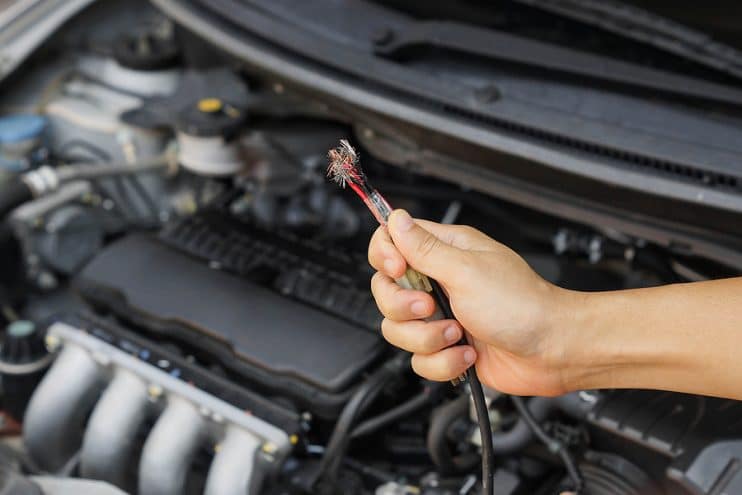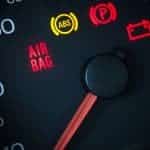
You’re in the right place if you’re wondering why your airbag warning light is lit up. We’ve got seven reasons why an airbag warning light turns on unexpectedly. Plus, find out whether you can drive with your airbag light turned on, and discover how much it might cost to fix the problem professionally.
Table of contents:
- Why has my airbag warning light suddenly turned on for no reason?
- Can I reset the airbag myself?
- Can I drive with an airbag light on?
- How much does it cost to fix the problem?
Why has my airbag warning light suddenly turned on for no reason?
An airbag warning light coming on unexpectedly while you’re out on the road can be concerning. It can indicate a problem with your car’s Supplemental Restraint System (SRS), which comprises multiple crash sensors and airbags. Any potential issues need to be resolved quickly, as it may stop your airbags from deploying in the event of a crash. We’ll walk you through some of the most common causes and solutions to the issue.
Faulty or damaged sensors
The airbag system in your vehicle relies on an extensive network of sensors called the Supplemental Restraint System (SRS). These sensors detect rapid deceleration or a collision and deploy the airbags. If just one of these crash sensors fails or sends faulty data, it can activate the airbag warning light even without an actual crash or issue with the airbags themselves.
The specific diagnostic trouble code can help identify which sensor may be involved. A technician can then test, recalibrate or replace the sensor. For example, you may only need a replacement ABS sensor to fix the issue instead of a whole new SRS system to correct the problem.
Wiring faults
The airbag system has a lot of complex wiring connecting all its different parts, from the crash sensors to the inflatable airbag modules. If any of the wires are damaged, detached or affected by corrosion, this can interrupt the communication within the system, and your airbag light will come on.
Faulty wires can be challenging to fix yourself, from tracking down the problem connection to rewiring correctly, so it’s best to ask a trusted mechanic to take a look instead.

Damaged clock spring
The clock spring is a coil of wires inside your steering wheel column. It acts like an extension cord, sending electrical power and signals from your steering wheel to your horn and airbags.
If the wire coil gets bent, cut, or frayed, it stops delivering those signals and power properly, so your vehicle’s computer thinks there’s an issue with your airbags and decides to turn on the airbag warning light as a precaution.
Replacing the damaged clock spring will restore the circuit connections and turn off the airbag light.
Wet or corroded airbag module
When water or corrosion gets into your airbag modules behind the steering wheel or the dashboard, it can damage the electrical wiring and sensors inside. As the sensitive electronics get wet or rusty, they may stop working correctly. Before your airbags fail, the computer realises there’s a problem and turns on the warning light.
You’ll need to get your airbag modules inspected and dried out, or you might need to replace them altogether if the damage is too extensive.
Your seatbelts aren’t locked correctly
The seatbelts and airbags work together to protect you in a crash. So if your car detects your seatbelts aren’t working right, it also assumes there could be a problem with the airbags.
Issues like torn seatbelts, sticky retractors, or broken sensors can trigger your car’s computer system to turn on the airbag warning light. So, fix any faulty seatbelt components immediately so they function correctly in the event of an accident.
Airbag warning light wasn’t reset after a collision
You must always have your vehicle serviced after a crash or accident and if your airbag was deployed. The whole airbag needs to be replaced, and the airbag needs to be reset.
Your airbag is switched off
Some vehicles have an option to manually turn off the passenger airbag, for example, if you have a child car seat in the front seat. If you turn it off, it triggers the airbag warning light as a reminder that the airbag protection is disabled.
The light stays on continuously on the dashboard until the switch is set back to “on” mode to reactivate the airbag. That way, you’ll know if your passenger airbag system is fully functional or temporarily deactivated before you head out on the road.

Can I reset the airbag myself?
No, don’t do it yourself. Airbag systems are technically complex and very sensitive. Without special tools and training, you can’t see the diagnostic codes to know the underlying problem and risk making mistakes.
Instead, take your car to a professional mechanic anytime the airbag warning appears. They can diagnose the exact issue, fix it properly, and then reset the light once everything checks out. Doing it yourself seems easy, but it can mask serious safety problems. Spend the money and leave it to experienced experts rather than risk incorrect repairs and compromise your and your passengers’ safety.
Can I drive with an airbag light on?
Technically, yes – it’s not illegal to drive with your airbag light on in the UK. But you are taking a risk as it’s doubtful you know what the underlying problem is (unless you know the airbag is turned off, that is).
Having said that, an illuminated light will cause your car to fail its MOT, and it is illegal to drive a vehicle in the UK without an MOT certificate. So don’t risk a heavy fine, points on your licence, a ban from driving or severe injuries in a collision, as all of these are possible when you ignore an illuminated airbag light. Take your car to your mechanic, have it checked out, and reset the light if needed.
How much does it cost to fix the problem?
The cost to fix an airbag warning light issue varies wildly, depending on the underlying problem and your vehicle’s make and model. Here are some general estimates to give you an idea of what you might need to pay.
A basic diagnostic scan: If a mechanic or garage needs to read any diagnostic trouble codes stored in the airbag module computer and assess the system condition, this is often an affordable starting point, usually under £50.
Repairs to individual components: If a faulty clock spring, bad sensor, or other component has caused the issue, expect to pay anywhere between £50 and £250 for the new parts and add a couple of hours of labour on top.
Entire airbag module replacement: If there is a complex problem that requires the whole module to be replaced, this can be pricey. Replacement airbag modules come in at around £700 to £1,000 or more.













.png)